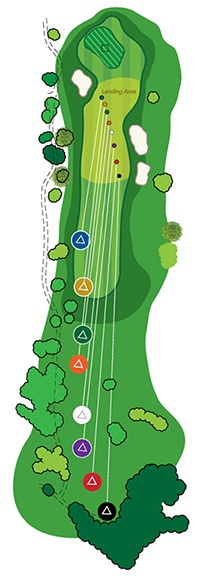Longleaf Tee Initiative
Golf course operators, teaming with a golf course architect, strategically expand existing tee complexes, which increases rounds, and improves pace of play and the facility’s bottom line. The goal is for all players to enjoy the game while maintaining the design integrity and challenge of the layout.






Royal Little
Family
Foundation
It’s going to benefit everybody in the game.”
Rees Jones, ASGCA Fellow
“It’s not about gender or age. It’s about playing from a distance that gives players a chance to have par on virtually every hole.”
Dan Van Horn, U.S. Kids Golf Foundation founder
How it Works
“Distinct signs on the practice range make it simple: hit a few drives, see where your ball lands, and play from the corresponding tees on the course,” Bergin said. “The charts and illustrations found in the pro shop, on the range, first tee and scorecard elevate this over other tee initiatives. It’s packaged in a way that encourages more players to play from the correct tees.”
The Longleaf Tee Initiative is not a “cookie cutter” program. Since each golf course is unique, the implementation of the tee system will vary based on course design and layout.
Additional implementations of the Longleaf Tee System are being implemented at Medinah No 2 in Illinois (Rees Jones, ASGCA Fellow and Steve Weisser, ASGCA), and Sugar Creek Country Club in Texas (Jeff Blume, ASGCA).
“It is vital that courses work with an ASGCA member from the start,” said John Crowder, USKGF. “No two courses are the same. And to design and implement a system for all players – not just kids, women or older players – you need the expertise of a golf course architect.”
To find an ASGCA member, click here. If you have any questions concerning the Longleaf Tee Initiative, email marc@asgca.org.

Longleaf Tee Initiative Case Studies
Fun for everyone
Simsbury Farms was one of the golf courses selected to receive a pro bono consultation from the United States Golf Association and the ASGCA Foundation.
One of its goals is to make the golf course become more inclusive to all skill levels and groups.
Golf course architect A. John Harvey, ASGCA, was part of the USGA/ASGCA Site Evaluation Program for Simsbury Farms. He confirmed that the club is already doing some work with forward tees (as reflected by its scorecards) and has cut out teeing areas alongside the fairways on a few holes at the edge of the rough where it can place simple tee markers. “I feel teeing areas such as forward tees promoted by the ASGCA’s Longleaf Tee System Initiative can appropriately cater to an enhanced variety of players to promote enjoyment of the game,” he says. “It’s an initiative that in my opinion helps to make the game more fun for everyone. Under the guise of an experienced golf course architect and working together with course management professionals, a plan for tasteful and appropriate teeing areas can be incorporated into the flow of the course that carefully balances playability, costs, benefits and maintenance considerations.”
Golf for all
Members at Sugar Creek Country Club will soon be able to play on the newly renovated Robert Course (one of the three sets of nine holes at the club), which not only includes new golf holes, tees, greens and fairways, but a new set of short tees designed to accommodate players of all skill level.
The club’s general manager, Gordon Wagner, says that the renovation with Jeff Blume, ASGCA, has proved an ideal opportunity to take the club’s oldest—and, previously, least desirable—nine holes of golf, and turn them into something fun.
“The plan has been to make the course more appealing to everyone—children, families and older players, particularly those that are considering downgrading their membership,” he explains.
Wagner first came across the concept of multiple tees after reading an article in Club and Resort Business in 2015 by Bill Donohue, which talked about kids’ tees, short tees, quicker tees and so on. “The article mentioned a successful initiative at a club in Michigan, which not only built in new short tees, but changed its program so that for three to four days a week, the course was designated for short tees,” Wagner explains.
“It was committed to growing participation, and the club’s board and membership really got behind the initiative. I looked at what they had achieved and thought it was genius!”
While he is hopeful about the appeal of the new short tees at Robert Course, Wagner recognizes the importance of communicating changes to members, and encouraging them to get behind it. “Members need to know what it is all about,” he says. “The club has to be completely committed, which means programming, programming, programming—nine hole night competitions, nine hole par three events and more. Ultimately, it’s about giving players a sense of freedom that they’ve never experienced before.”
A course within a course
Jan Bel Jan, ASGCA, introduced the concept of ‘scoring tees’ in 2011, when she worked on a project at Green Valley Country Club in Greenville, South Carolina, to open up the game to more players than ever. She has since expanded the concept at Pelican’s Nest Golf Club in Bonita Springs, Florida, by using on-site fill generated during the renovation of the Club’s Hurricane Course to add scoring tees.
The concept is based on locating scoring tees forward of existing tees in such a way that penal hazards are either eliminated or can be managed more easily.
At Pelican’s Nest there are seven different sets of tee markers, which are indicated with Roman numerals.Scoring tees have their own designation, the ‘S’ tee, with their own scorecard and ratings for men and women.
“The fact that the club honors the Scoring Course with its own name and scorecard emphasizes that this is an official ‘course within a course’, that it provides an alternative challenge, and that it is age, gender and skill neutral,” says Bel Jan. “By creating these formal teeing grounds, the club proclaims ‘we want you here’ whether you are a junior, super-senior or scratch player.”
Immediate advantages of using scoring tees are that golfers have more fun and enjoy faster play. “Scoring tees allow more players to follow the USGA/PGA’s encouragement to ‘tee it forward,’” says Bel Jan. “We’ve seen that once players experience better scores because they can more often reach the greens in regulation, they are less interested in going back to a longer course. Enthusiastic participation will almost surely result in increased pace of play and rounds played as well as in greater satisfaction by the members.”
A ‘living laboratory’ for growing golf
In 1987, Dan Maples, ASGCA Past President, took 170 acres of North Carolina land and designed and developed a golf facility that included a clubhouse, driving range, tennis courts and more. Longleaf Golf & Country Club held its grand opening in November 1998.
By 2015, U.S. Kids Golf Foundation (USKGF)—maker of golf equipment for kids—was looking for what their president Dan Van Horn describes as “a living laboratory for growing kids and family golf in a club environment, implementing best practices in a real-life situation.” They found this laboratory at Longleaf, buying the property and working with Bill Bergin, ASGCA, to bring their vision to reality. They renamed the facility Longleaf Golf & Family Club.
A key feature of the redesign was the conversion of the club’s traditional four tee pads per hole to a new system developed by USKGF.
Following extensive data analysis, it was determined that on any given course there would ideally be a total of 600 yards of separation over a typical 18-hole layout between each tee marker option. Beginning with 3,200 yards from the forward tees, most golf courses can be fit with six, seven or even eight yardage options to choose from. The gap between markers on each hole is about 30 yards, but that decreases on par threes and increases on par fives.
With a broader range of tee locations, every golfer, regardless of skill, can play at a good pace, shoot lower scores, and have more fun.
At Longleaf, they settled on a seven-tee system, following the principles set out above but also factoring in the course’s topography, choosing locations that facilitated ease of construction.
Forty tee pads were constructed, mostly related to size or conditioning rather than location. 29 tees were cut into existing fairways, of which four had to be shaped and a few more may be modestly levelled in future. Because of the increased number of tees, size-
per-tee could be reduced, and many existing tees could be reduced by simply adjusting mowing lines.
The back tees and more heavily-used middle tees may hold more than one set of markers each, and are respectively about 800 sq. ft. and between 900-1,200 sq. ft. each. The forward two-to-three sets of tees are smaller, approximately 400 sq. ft. each.
With the tees in place, the next challenge for Longleaf was to communicate the system effectively to golfers. A crucial part of this is clear signage. “The charts and illustrations elevate this over other tee initiatives. From the pro shop and range to the first tee and scorecard, it is all packaged in a way that encourages more players to play from the correct tees,” says Bergin. On the practice range, there is a guide for golfers that shows which tees they should use, which is determined by the distance they hit their drives.
“The beauty of the Longleaf Tee System is that you don’t lose the integrity of the design,” says Jeff Cowell, General Manager of Longleaf Golf & Family Club. “It’s not just an arbitrary layout of the tees to make a hole shorter. So most importantly, the players still feel a sense of great accomplishment and fun as they play. Since Bill’s work here at Longleaf, our total rounds are up nearly 20 percent over a year ago and I’m hearing from a lot of happy members and guests.”
“This tee system has given me a completely different confidence about playing,” says Longleaf Golf & Family Club member Emily Simeon. “I can go out and play with many people who are much better golfers than I am—and I can compete.”
A program for success
This summer 2017, a project to restore the No. 2 Course at Medinah Country Club is set to reach completion.
Work at the course is being led by Rees Jones, ASGCA Fellow, and Steve Weisser, ASGCA, under the guidance of Medinah’s Director of Golf Course Operations Curtis Tyrrell. Their aim is to restore the course to the original design of Tom Bendelow, but they’re also introducing some exciting new features to make it more attractive to players of all abilities.
The No. 2 course is the club’s shorter course, and has always been popular with higher handicappers, ladies and juniors. Recognizing that it needs to stay relevant and do what it can to make the course more fun to play, the club has gone ahead with plans to introduce its ‘Golf For Life’ program – a unique set up, which involves multiple sets of tees per hole to appeal to golfers of all skill levels.
“This type of program is being incorporated at a number of golf courses around the country to help the game grow and keep people in the game,” Jones said in an interview with Golf Course Architecture. “Medinah wanted to take a leadership role in introducing this program. There are seven sets of tees. When a beginner takes up the game, they can play the forward tee and as they get better they keep moving back. Then, as you get older and you can’t hit it as far, you start moving forward again. I think this is going to be a golf course that every caliber of player, from the entry level player to the young player to the older player, can play and enjoy if they play the proper tees.”
According to Robert Sereci, the club’s general manager and COO, this development reflects the need to move the needle on the game and cater to all. “We have more members coming in than we have had in eight years,” he says. “You can have all the gimmicks and payment plans, but ultimately you have to give them something to show up for. We believe that our new ‘Golf For Life’ program does exactly that.”
What makes ‘Golf For Life’ unique is that it offers up a comprehensive program designed to help players build up the skills they need to improve their game. Each member meets with professional staff for a game evaluation, is assigned one of seven tee boxes as starting point, and then begins a structured system for improvement.
Sereci says that the club has already begun explaining the program to its membership, and they have embraced it. “All of the measures we are putting in place are designed to make playing golf at Medinah more vibrant and fun,” he explains.
the overall benefit for the golfer and the game.”
Jason Friedman, superintendent, Longleaf Golf & Family Club
“ASGCA members must help clients determine what is best; whether building new tees or fairway cutouts,
or simply using these ideas for better operations.”
Bruce Charlton, ASGCA
